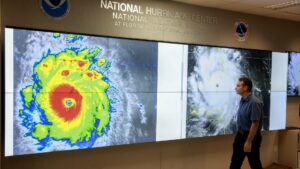Preparing for an Above-Average Hurricane Season: Insights from Extreme Investor Network
As the summer months approach, discussions around hurricane preparedness and impacts become increasingly relevant. On July 1, 2024, the National Oceanic and Atmospheric Administration (NOAA) issued a forecast indicating a significant likelihood of an above-average hurricane season for 2025, with predictions of 13 to 19 named storms, including 6 to 10 that could reach hurricane status. This forecast highlights the need for proactive measures within communities in vulnerable areas.
Understanding the Risks: What This Means for Communities
According to Laura Grimm, acting administrator of NOAA, the predictions also serve a crucial purpose—preparing communities for the impending storms that could affect thousands of lives and properties. At a recent press conference in Jefferson Parish, Louisiana, Grimm emphasized the impact of advancements in weather prediction technologies that have led to successful forecasts in recent years.
While the focus remains on accurate forecasting, communities must consider actions beyond preparedness. The rising frequency of severe storms and their destructive potential have been underscored by recent events: Hurricanes Helene and Milton in 2024 alone resulted in over $37 billion in insured losses. This context serves as a wake-up call for homeowners, businesses, and insurers alike.
Economic Implications of Natural Disasters
Interestingly, despite the turbulence brought on by hurricanes, the U.S. property casualty insurance sector reported its best underwriting performance since 2013. However, amidst this upbeat news, challenges loom. January’s California wildfires are expected to inflict over $50 billion in losses, while severe storms have similarly impacted the Midwest, with 883 local tornado reports this year—35% higher than the historical average.
The cycle of economic strain and recovery is intricate. As Bill Clark, CEO of Demex, outlined, surging reinsurance costs for storm-related events are reaching a 20-year high. This scenario limits the ability of insurers to manage escalating losses, which can lead to increased premiums for consumers.
The Call for Resilience and Mitigation
Both government agencies and insurance companies are beginning to recognize the urgency of building resilience within at-risk communities. Improved building codes, strategic public works projects, and creating defensible spaces around structures are paramount to mitigating the impacts of future storms. Cynthia Lee Sheng, president of Jefferson County Parish, reinforced this idea by sharing that investment in mitigation strategies has historically yielded significant returns, estimating that $13 is saved for every $1 spent on such initiatives.
Since Hurricane Katrina, a watershed moment for disaster management, local governments and agencies have transformed how they prepare for and respond to disasters. Enhanced collaboration among key agencies has paved the way for better coordination during emergencies, enabling communities to rebound more effectively from devastating events.
By staying informed about the implications of climate change, investing in resilience, and supporting local initiatives, individuals can safeguard themselves and contribute to stronger, more prepared communities. At Extreme Investor Network, we advocate for not just preparation but informed action—ensuring that everyone has the information they need to navigate both risks and opportunities in this changing landscape.
Conclusion
As we open another hurricane season, awareness and preparation are the keys to safeguarding lives and property. By understanding the predicted trends and embracing innovative resilience strategies, communities can not only weather the storms but also thrive in their aftermath. Stay tuned to Extreme Investor Network for ongoing insights and expert guidance that can help you navigate these complexities effectively.

